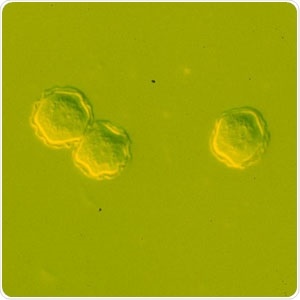Acanthamoeba is a genus of opportunistic protozoan amebic species widely distributed in nature. Furthermore, it is part of a broader family of free-living amebae that can autonomously survive in the environment, but can also parasitize in human, the host, and result in serious infections.

Cysts of Acanthamoeba spp. in culture. Image Credit: CDC - DPDx
Discovered in 1930 as a contaminant of yeast culture, it has become increasingly appreciated in the last few decades due to its potential to cause diseases in contact lens wearers and immunocompromised individuals, but also due to its ability to act as a reservoir for various pathogens such as viruses, bacteria, and fungi (thus sometimes dubbed “Trojan horse of the microbial world”).
Three main types of rare clinical syndromes can be caused by Acanthamoeba –fatal granulomatous amebic encephalitis that involves the brain and spinal cord, Acanthamoeba keratitis that involves the eye, as well as disseminated infection that often manifests with various skin lesions.
Granulomatous Amebic Encephalitis
Initially, the term “granulomatous amebic encephalitis” was coined mainly to describe brain infection caused by Acanthamoeba species. Nevertheless, it has been shown that other free-living amebae (specifically Balamuthia mandrillaris and Sappinia diploidea) can result in analogous clinical presentation.
Acanthamoeba most often affects the posterior structures of the brain in individuals with underlying diseases such as diabetes, various malignancies, renal failure, systemic lupus erythematosus, and human immunodeficiency virus. Other predisposing factors include organ transplantation, drug abuse, chemotherapy or radiotherapy, as well as alcoholism.
Early clinical diagnosis of this condition is often cumbersome as symptoms mimic ischemic stroke or some other type of infectious encephalitis. In this stage, the disease usually manifests with confusion, headache, fever, stiff neck, lethargy, and focal neurologic deficits. As the infection worsens, the signs of raised intracranial pressure predominate, inevitably leading to coma and death.
Acanthamoeba Keratitis
Acanthamoeba keratitis represents a multifactorial process usually associated with the use of contact lenses. It can also be found in non-contact lens wearers, especially those with low levels of IgA antibodies in their tear film or changes in the surface of the cornea.
The process starts with the disintegration of the epithelial barrier and stromal invasion by Acanthamoeba, which induces a vigorous inflammatory response and subsequent stromal necrosis with potential blinding. There is also a possibility of bacterial superinfection that further complicates timely diagnosis.
Symptoms are usually restricted to one eye and include pain, swelling, redness, tearing, photophobia (light sensitivity), blepharospasm (abnormal contraction of the eyelid), as well as blurred vision in cases when corneal lesion involves the visual axis.
Disseminated Infection and Skin Lesions
If Acanthamoeba enters the skin through a wound or the nostrils, the organism can travel through the bloodstream, spread to other organ systems, and result in a disseminated infection. The clinical course in such cases can be fulminant with swift progression to death.
Infection with Acanthamoeba species can also manifest with various skin lesions that usually start as firm papular nodules, subsequently developing into indurated ulcerations. It is still not completely clear whether such skin manifestations arise as a primary focus of infection or as a result of hematogenous spread from other sites.
If they are examined histologically, the aforementioned cutaneous lesions are often characterized by focal necrosis surrounded by inflammatory cells, vasculitis, and amebas themselves. Still, even then the condition can be confused with other infections caused by viruses, fungi, or mycobacteria – especially if the organism is not visualized in the single biopsy specimen.
Further Reading